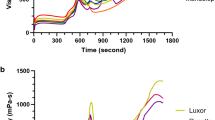Abstract
Composition, solubility, bound sugar content and quality, subunit composition and structure of the storage proteins of seeds ofLupinus albus are discussed. Aminoacid composition is also given for each protein, the various protein classes and the whole flour. These data allow for the characterization of the molecules of the various storage proteins and their contributions to the nutritional properties of the seed.In vitro digestibility (by mammalian endopeptidases) is reported and is less than for animal proteins. Possible causes, at the molecular level, for this behaviour and possible means to overcome these effects are examined. The relationships between the above data are considered in view of the nutritional performance of the proteins and of the genetical, agronomic and technological approaches most suited to improve the nutritional quality of lupine seeds as a protein source.
Similar content being viewed by others
References
Basha Shaik MM, Beevers L (1976) Glycoprotein metabolism in the cotyledons of Pisum sativum during development and germination. Plant Physiol 57:93–97
Cerletti P, Fumagalli A, Venturin D (1978) Protein composition of seeds of Lupinus albus. J Food Sci 43:1409–1412
Cerletti P, Duranti M (1979) Development of lupine proteins. J Am Oil Chem Soc 56:460–463
Danielsson CE (1952) A contribution to the study of the synthesis of the reserved proteins in ripening pea seeds. Acta Chem Scand 6:149–159
Derbyshire E, Wright DJ, Boulter D (1976) Legumin and vicilin, storage proteins of legume seeds, Phytochemistry 15:3–24
Duranti M, Cerletti P (1979) Aminoacid composition of seed proteins of Lupinus albus, J Agric Food Chem 27:977–978
Duranti M, Restani P, Poniatowska M, Cerletti P (1981) The seed globulins of Lupinus albus. Phytochemistry 20:2071–2075
Gillespie JM, Blagrove RJ, Randall PJ (1978) Effect of sulphur supply on the seed globulin composition of various species of lupin. Austr J Plant Physiol. 5:641–650
Hove EL, King S, Hill GD (1978) Composition, protein quality and toxins of seeds of the grain legumes Glycine max, Lupinus spp., Phaseolus spp., Pisum sativum and Vicia Faba. N.Z. J Agric Res 21:457–462
Hudson BJF, Fleetwood JG, Zand Mahaddam A (1976) Lupin: an arable food crop for temperature climates. Plant Foods for Man 2:81–90
Itzhaki RF, and Gill DM (1964) A micro-biuret method for estimating proteins, Anal Bioch 9:401–409
McCaldin DJ (1960) The chemistry of ninhydrin, Chem Rev 60:39–51
Moore S, Stein W (1954) Modified ninhydrin reagent for the photometric determination of aminoacid and related compounds, J Biol Chem 211:907–913
Restani P, Duranti M, Cerletti P, Simonetti P (1981) Subunit composition of the seed globulins of Lupinus albus. Phytochemistry 20:2077–2083
Author information
Authors and Affiliations
Rights and permissions
About this article
Cite this article
Cerletti, P., Duranti, M. & Restani, P. Properties of lupine proteins relevant to their nutritional performance. Plant Food Hum Nutr 32, 145–154 (1983). https://doi.org/10.1007/BF01091335
Issue Date:
DOI: https://doi.org/10.1007/BF01091335



